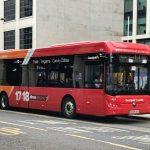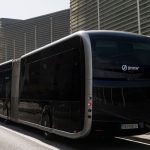The government part-funded over 1,000 hybrid double-deckers between 2009-2013. We talk to five different operators about how they have fared on the road
When it comes to green public transport, the UK is one of the best performers in the world. London has the biggest fleet of electric buses in Europe, and many of Britain’s other cities aren’t far behind.
That’s thanks largely to the government’s Green Bus Fund, first announced in 2009, which in total provided £89m for operators to pioneer otherwise unaffordable green vehicles. Later replaced by the Ultra Low Emission Bus Scheme, it ran through four rounds between 2009-2013, and doubtless did much to accelerate the manufacture and purchase of cleaner-engined buses in the UK.
But of the 1,240 vehicles bought through the Green Bus Fund, a staggering 1,057 of them were electric-diesel hybrids, with the remaining 183 single-deck gas and electric buses; double-deck options were limited to hybrid at the time.
And now that full-electric buses of most sizes are not only designed and manufactured, but becoming well proven in operation, where does that leave their slightly less green, hybrid counterparts?
Performance on route
Brighton and Hove Buses took delivery of 13 Wrights Volvo hybrids in 2012-13. They were allocated to the city’s high-frequency route 7, which serves the city’s low-emission zone, with heavy passenger loadings.

Martin Harris, MD, says: “We were broadly happy with them in this role, subject to the known limitations of the hybrid system developed then, and the impacts of highway design and traffic flows on their ability to delivering on the promise.”
Those 13 are still with the operator, but were moved to route 2 two years ago, which still serves the ULEZ but with lower frequency and lower passenger loadings. While there are some engineering issues with the conventional hybrids, says Martin, “we remain broadly content with their performance on this route.”
Ensign Bus in Essex also took the Volvo-Wrightbus combination in 2012 – six of them, which have spent their lives on route 22, from Grays to Aveley.
Ensign plans to sell them next year. “The older they get, the lower the efficiency, because the batteries lose their power,” says Peter Newman, MD. “Having said that, Volvo stated that they would require new batteries after five years, and they still have the original ones.
“One of the reasons that they will be going next year is the cost of renewing the batteries.”
Stagecoach Manchester is still using the majority of the 144 hybrids it took six-nine years ago on the same intensive urban routes. “The performance in terms of MPG has reduced from when they were new, but they are still significantly better than other comparable conventional vehicles,” says Ben Jarvis, Commercial Director.
“In the first year the average consumption was around 8.5mpg, and this has levelled off at just under 8mpg – whereas a conventional bus will be 6-6.5mpg.”
Battery life
Oxford Bus Company and its subsidiary Thames Travel has operated ADL hybrids for eight years, and Volvo hybrids for seven, a number of which have had their batteries replaced.
MD Phil Southall says: “As we took out an extended manufacturer’s battery warranty it was covered under this.”

He adds: “These warranties added around £500,000 to my annual costs.”
Stagecoach Manchester has also replaced battery cells under warranty. Ben Jarvis says: “The warranties are a significant cost that result in around a 15-20% higher cost of operation than conventional vehicles.
“With the grant funding they are still more expensive to operate than conventional buses, because of the increased maintenance costs caused by the extended warranties and increasing complexity.
“The funding was for 50% of the difference in value to a conventional bus, so the additional depreciation costs are also higher. So the fuel cost savings and additional BSOG benefits do not outweigh the cost increases.”
First UK Bus operates 164 hybrids, the vast majority of which are still operating the same type of services they were bought for.
While their efficiency has been more or less consistent, a spokesperson for First says: “There were specific engineering maintenance challenges due to the nature of having combined electrical and hydraulic components, which required a different engineering maintenance regime.”
Catalyst for change?
When asked if operating hybrids has led to the company buying any more hybrid or electric vehicles, Phil Southall says: “The reverse is true. Due to the expense, it makes sticking with Euro VI as long as possible more appealing unless an outside body funds the difference in total life costs, rather than just the purchase price.”
“Diesel is not the demon it is portrayed as,” says Peter Newman. “Certainly the old ones were smoky, but the latest Euro VI has eliminated 94% of NOx, which was the primary problem.

“Therefore in our opinion diesel is the way forward. People forget that the end user, ie. the passengers, will land up paying the cost of electric or hydrogen, and you have to ask why, when the latest diesel is almost as clean.”
However, for Stagecoach Manchester, the hybrids have been a useful introduction to electric. “They have given us a lot of working knowledge with the operation of battery technology and traction motors,” says Ben Jarvis, “so we feel we are in a good place to operate the 32 full-electric buses due in the next six months.”
The hybrids have also provided a useful lesson for First. “First currently operates hybrid alongside diesel, hydrogen, biogas and electric,” the operator’s spokesperson says. “This provides us with essential in-depth knowledge and hands-on experience necessary to inform our future fleet strategy.
“The market has moved on since the introduction of hybrids, and for a number of reasons First won’t be investing in hybrid technology going forward.”
The future
Of the operators we spoke to, Stagecoach Manchester is now replacing hybrids with Euro VI diesels, cascading the hybrids to other service work in the city.
Ensign Bus is planning to sell its hybrids next year, and will also be sticking to diesel for new buses. “Ask me whether we would buy electric, and the answer is ‘if somebody else was paying for them’,” says Peter Newman.
Brighton and Hove is still investing in a kind of hybrid technology – ADL’s extended range hybrid electric buses, geofenced to run as pure-electric within the city centre’s Ultra Low Emission Zone, as well as Wrightbus micro hybrids.
“Attention has naturally been increasingly turned to the options in respect of batteries and full life costs and residual values,” says Martin Harris.
“We have not bought any further conventional hybrids, but have invested heavily in Euro VI micro hybrids – 85 at the last count.”
As Brighton and Hove requires a 200-miles-per-day range on hilly terrain, it is still waiting for full-electric double-deckers that can meet its requirements. Its sister operation in Crawley, Metrobus, has obtained funding for 20 fuel cell electric buses. “This is now the principle alternative fuel that we are currently exploring,” says Martin.
And in the meantime, the 30 ADL extended range hybrids will enter service in the next few weeks.
Other operators have less positive legacies.
Phil Southall says: “They are very expensive buses to operate, and attract the highest spend per bus in our entire fleet by quite some margin.”
‘World has moved on’
First says: “Hybrids were the right technology at that time, as they promised better efficiency, fuel economy and reduced emissions. The government funding allowed the market to adopt hybrid technology and put it to the test in a demanding operational environment.

“The world has moved on since the introduction of hybrids; other technologies such as efficient Euro VI diesel and electric vehicles have greatly improved and now deliver much better performance, better fuel economy and a significant reduction in emissions.
“So for technology reasons, and our commitment to switch to 100% EV, we won’t be investing in hybrid technology going forward,” First says.
While they have presented headaches to their operators thanks to complex maintenance regimes and necessary battery work, the hybrids part-funded by the Green Bus Fund less than 10 years ago are solid, valuable vehicles built by respected manufacturers, and they should have plenty of life left in them yet.
As hundreds of them reach the secondhand bus market in the next few years, it remains to be seen how well they’ll be received, and how useful they’ll prove on different types of work.
























